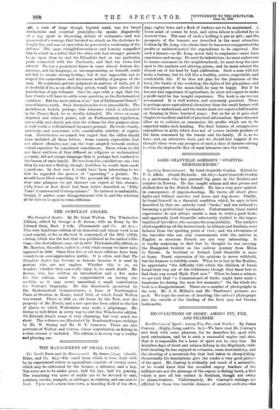THE MANAGEMENT OF SMALL FARMS.
Tice Small Farm and its Management. By James Ilireg. (Smith, Elder, and Co. 6s.)—The small farm which is here dealt with by an experienced writer on agriculture consists of twenty acres, which may be cultivated by the farmer, a labourer, and a boy. Ten acres are to be under grass, half for hay, half for grazing. The remaining ten acres of arable are to be devoted to oats, potatoes, swedes, mangels, or cabbages in rotation, and one acre to fruit. Upon such a farm four cows, a breeding flock of ten eves, pigs, eighty hens, and a flock of turkeys are to be maintained. A horse must of course be kept, and extra labour is allowed for iu harvest time. The rent of such a holding is put at £35 ; and the prospects of the tenants are described in the most attractive fashion by Mr. Long, who claims that he has never exaggerated the profits or underestimated the expenditure to be expected. ' But such a farmer—as Mr. Long never fails to emphasise—must have experience and energy. He must be industrious ; he must endeavour to secure customers in the neighbourhood; he must keep his eyes open to the markets and altering prices ; and he must extract the utmost out of his land by high cultivation. Such a man will not make a fortune, but he will live a healthy, active, respectable, and comfortable life. If he does not pine for the pleasures of the town, the bustle of the workshop, the lights of the gin-palace, and the atmosphere of the music-hall, he may be happy. But if he has not had experience of agriculture, he must not expect to make a profit until he has bought experience. The book is one we can recommend. It is well written and extremely practical. There is perhaps more agricultural chemistry than the small farmer will care for or understand, and the reader must not expect a full treatise on farming in three hundred pages. But as far as it goes each chapter is excellent and full of practical information. Space does not allow us to criticise or summarise the profits which are to be expected under each heading. The final balance of receipts over expenditure is £120, which does not of course include produce of the farm consumed by the tenant and his family. It is, as we have said, an attractive book, and we should feel happier if we thought there were any prospect of such a class of farmers arising to stem the deplorable flow of rural labourers into the towns.


















































 Previous page
Previous page